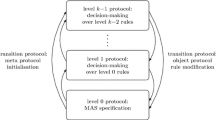Abstract
This paper presents a proof of concept for a graphical models approach to assessing the moral coherence and moral robustness of systems of social interactions. “Moral coherence” refers to the degree to which the rights and duties of agents within a system are effectively respected when agents in the system comply with the rights and duties that are recognized as in force for the relevant context of interaction. “Moral robustness” refers to the degree to which a system of social interaction is configured to ensure that the interests of agents are effectively respected even in the face of noncompliance. Using the case of conscientious objection of pharmacists to filling prescriptions for emergency contraception as an example, we illustrate how a graphical models approach can help stakeholders identify structural weaknesses in systems of social interaction and evaluate the relative merits of alternate organizational structures. By illustrating the merits of a graphical models approach we hope to spur further developments in this area.














Similar content being viewed by others
Notes
For this paper, the freely available yEd Graph Editor was used to produce the diagrams: http://www.yworks.com/en/products/yfiles/yed/.
In Cantor’s and Baum's (2004) words, “Society does not require professionals to abandon their morals.” Additionally, the pharmacists “owe their customers a duty of care” according to their best personal judgment. Furthermore, Cantor and Baum (2004) state that the right to only engage in action that are in harmony with personal believes is an important part of a free and democratic society.
References
Atman, C. J., Bostrom, A., Fischhoff, B., & Morgan, M. G. (1994). Designing risk communications: Completing and correcting mental models of hazardous processes, part I. Risk Analysis, 14, 779–788.
Binmore, K. G. (1994). Game theory and the social contract. Cambridge, MA: MIT Press.
Cantor, J., & Baum, K. (2004). The limits of conscientious objection—may pharmacists refuse to fill prescriptions for emergency contraception? New England Journal of Medicine, 351, 2008–2012. doi:10.1056/NEJMsb042263.
Chu, T., & Glymour, C. (2008). Search for additive nonlinear time series causal models. J Machine Learning Research, 9, 967–991.
Danks, D. (2014). Unifying the mind: Cognitive representations as graphical models. Cambridge, MA: MIT Press.
Fassin, Y. (2007). Imperfections and shortcomings of the stakeholder model’s graphical representation. Journal of Business Ethics, 80, 879–888. doi:10.1007/s10551-007-9474-5.
Freeman, R. E., & McVea, J. (2001). A stakeholder approach to strategic management. Rochester, NY: Social Science Research Network.
Glymour, B., Glymour, C., & Glymour, M. (2008). Watching social science the debate about the effects of exposure to televised violence on aggressive behavior. American Behavioral Scientist, 51, 1231–1259. doi:10.1177/0002764207312020.
Haigh, M. S., & Bessler, D. A. (2004). Causality and price discovery: An application of directed acyclic graphs. Journal of Business, 77, 1099–1121. doi:10.1086/422632.
Hoover, K. D., Demiralp, S., Perez, S. J. (2008). Empirical identification of the vector autoregression: The causes and effects of US M2. Economics Research Initiatives at Duke Working Paper No. 19. doi:10.2139/ssrn.1091249.
Horty, J. F. (2001). Agency and deontic logic. New York: Oxford University Press.
Kaufman, J. S., & Kaufman, S. (2001). Assessment of structured socioeconomic effects on health: Epidemiology. Epidemiology, 12, 157–167.
Levi, I. (1990). Hard choices: Decision making under unresolved conflict. Cambridge, New York: Cambridge University Press.
Lumina Decision Systems Analytica—Lumina Decision Systems. http://www.lumina.com/. Accessed October 25, 2015.
Pearl, J. (2000). Causality: Models, reasoning, and inference. Cambridge, New York: Cambridge University Press.
Pogge, T. W. (1992). Loopholes in Moralities. The Journal of Philosophy, 89, 79–98. doi:10.2307/2027153.
Raz, J. (1984). On the nature of rights. Mind, 93, 194–214.
Sachs, K., Perez, O., Pe’er, D., Lauffenburger, D. A., & Nolan, G. P. (2005). Causal protein-signaling networks derived from multiparameter single-cell data. Science, 308, 523–529. doi:10.1126/science.1105809.
Sen, A. (2002). Rationality and freedom. Cambridge, MA: Belknap Press.
Shipley, B. (2002). Cause and correlation in biology: A user’s guide to path analysis, structural equations and causal inference. Cambridge: Cambridge University Press.
Waldemark, J., & Norqvist, P. (1995). In-flight calibration of satellite ion composition data using artificial intelligence methods. Institutet för Rymdfysik, Swedish Institute of Space Physics, Kiruna, Sweden.
Wasserman, S. (1994). Social network analysis: Methods and applications. New York: Cambridge University Press, Cambridge.
Wicclair, M. R. (2011). Conscientious objection in health care: An ethical analysis. Cambridge: Cambridge University Press.
yWorks yEd—Graph Editor. http://www.yworks.com/en/products/yfiles/yed/. Accessed October 25, 2015.
Acknowledgments
We thank David Danks and Kevin Zollman for critical feedback on earlier versions of this work.
Author information
Authors and Affiliations
Corresponding author
Rights and permissions
About this article
Cite this article
Hoss, F., London, A.J. Assessing the Moral Coherence and Moral Robustness of Social Systems: Proof of Concept for a Graphical Models Approach. Sci Eng Ethics 22, 1761–1779 (2016). https://doi.org/10.1007/s11948-015-9743-0
Received:
Accepted:
Published:
Issue Date:
DOI: https://doi.org/10.1007/s11948-015-9743-0




